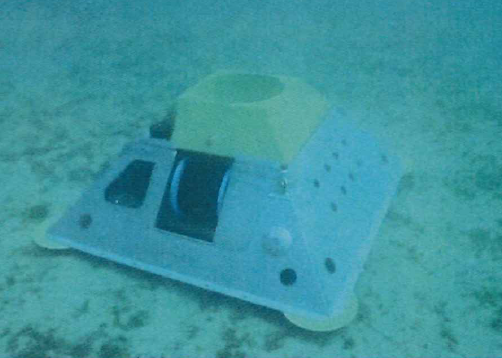JULIO - TIMESERIE #1 : Etude long terme de la variabilité du Courant Nord
JULIO (Judicious Location for Intrusions Observations) mooring is located close to the 100 m-deep isobath (around 5.25°E and 43.13°N), offshore Marseille. With its bottom-moored (300kHz) ADCP, it enables measuring horizontal currents (every 4 m and every ½ h) through the water column, and among others, identifying periods of exchange between the Northern Current and the continental shelf.
It is one crucial component in the study of the coastal-offshore gradient from Marseille to the MOOSE 42°N5°E station, and potential covariances with the MIO radar and other MIO or international observing systems, as well as with the SOMLIT site (including also an ADCP) in the bay of Marseille.
Moreover, with a bottom CTD, it can detect environmental anomalies in classical hydrographic data, useful for oceanographers. As one of the rare station at the interface between the continental shelf and offshore, it will allow to observe the long-term evolution of the Northern Current in the context of climate change and anthropogenic pressure, and its potential varying impact on the Gulf of Lion. The data are of course also crucial for modellers. Moreover they show a great potential when supplementing other MOOSE data (glider and radar).
Timeserie #1
- JULIO 1 - 12/02/2012 to 23/10/2012;
JULIO (Judicious Location for Intrusions Observations) est situé à proximité de l'isobathe de 100 m de profondeur (environ 5,25°E et 43,13°N), au large de Marseille. Grâce à son ADCP (300 kHz), il permet de mesurer les courants horizontaux (tous les 4 m et toutes les ½ h) à travers la colonne d'eau et, entre autres, d'identifier les périodes d'échange entre le courant du Nord et le plateau continental.
Il s'agit d'un élément crucial dans l'étude du gradient littoral-offshore de Marseille à la station MOOSE 42°N5°E, et des covariances potentielles avec le radar MIO et autres systèmes d'observation MIO ou internationaux, ainsi qu'avec le site SOMLIT (incluant également un ADCP) dans la baie de Marseille.
De plus, avec un CTD de fond, il peut détecter les anomalies environnementales dans les données hydrographiques classiques, utiles aux océanographes. En tant qu'une des rares stations à l'interface entre le plateau continental et le large, elle permettra d'observer l'évolution à long terme du courant du Nord dans le contexte du changement climatique et de la pression anthropique, et son impact potentiel variable sur le Golfe du Lion. Les données sont bien sûr également cruciales pour les modélisateurs. De plus, ils présentent un grand potentiel en complément d'autres données MOOSE (planeur et radar).
Série temporelle #1:
- JULIO 1 - 12/02/2012 to 23/10/2012;
Simple
- Date (Publication)
- 2019-10-01
- Citation identifier
- http://dataset.osupytheas.fr/geonetwork/srv/resources3a0e0311-ce44-4b9e-b043-445daf85f7b4
- Purpose
-
JULIO (Judicious Location for Intrusions Observations) mooring is located close to the 100 m-deep isobath (around 5.25°E and 43.13°N), offshore Marseille. With its bottom-moored (300kHz) ADCP, it enables measuring horizontal currents (every 4 m and every ½ h) through the water column, and among others, identifying periods of exchange between the Northern Current and the continental shelf.
- Status
- Completed
- Maintenance and update frequency
- Daily
-
GEMET - Concepts, version 2.4
-
-
Mediterranean Sea
-
sea circulation
-
environmental data
-
hydrography
-
-
GEMET - INSPIRE themes, version 1.0
-
-
Oceanographic geographical features
-
Sea regions
-
Hydrography
-
-
Continents, countries, sea regions of the world.
-
-
France
-
Mediterranean Sea
-
- Keywords
-
-
circulation long terme
-
ADCP
-
Golfe du Lion
-
- Access constraints
- Copyright
- Use constraints
- otherRestictions
- Spatial representation type
- Vector
- Denominator
- 5000
- Language
- English
- Character set
- UTF8
- Topic category
-
- Oceans
- Environment
- Begin date
- 2012-02-12
- End date
- 2012-10-23
- Description
-
Mediterranean Sea
))
- Supplemental Information
-
You can customize the template to suit your needs.
You can add
and remove fields and fill out default information (e.g. contact
details).
Fields you can not change in the default view may be accessible in the
more
comprehensive (and more complex) advanced view. You can even use the
XML editor
to create custom structures, but they have to be validated by the
system, so
know what you do :-)
- Reference system identifier
- WGS 1984
- Distribution format
-
-
fichiers NetCDF
(
1.0
)
-
fichiers NetCDF
(
1.0
)
- OnLine resource
- site web JULIO ( WWW:LINK-1.0-http--link )
- OnLine resource
- Digital Object Identifier (DOI) ( DOI )
- OnLine resource
-
fichier NCF - OS_MIO_JULIO-2012_D_ADCP.nc
(
WWW:LINK-1.0-http--link
)
Mesures de profiles de vitesse du courant au point JULIO par ADCP de fond
- Hierarchy level
- Dataset
- Statement
-
les données ont été acquises par un ADCP RDI
- File identifier
- 140621c0-7844-4390-9eb1-670d3df520e4 XML
- Metadata language
- English
- Character set
- UTF8
- Parent identifier
-
JULIO - Etude long terme de la variabilité du Courant Nord
3a0e0311-ce44-4b9e-b043-445daf85f7b4
- Hierarchy level
- Dataset
- Hierarchy level name
-
dataset
- Date stamp
- 2023-02-14T15:13:11
- Metadata standard name
-
ISO 19115:2003/19139
- Metadata standard version
-
1.0
Overviews


Spatial extent
))
Provided by

 OSU Pytheas - Data Catalog
OSU Pytheas - Data Catalog